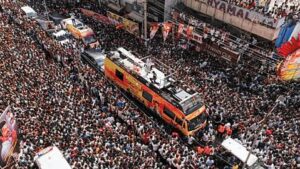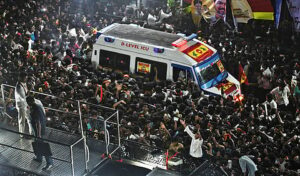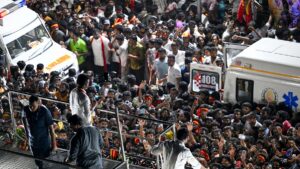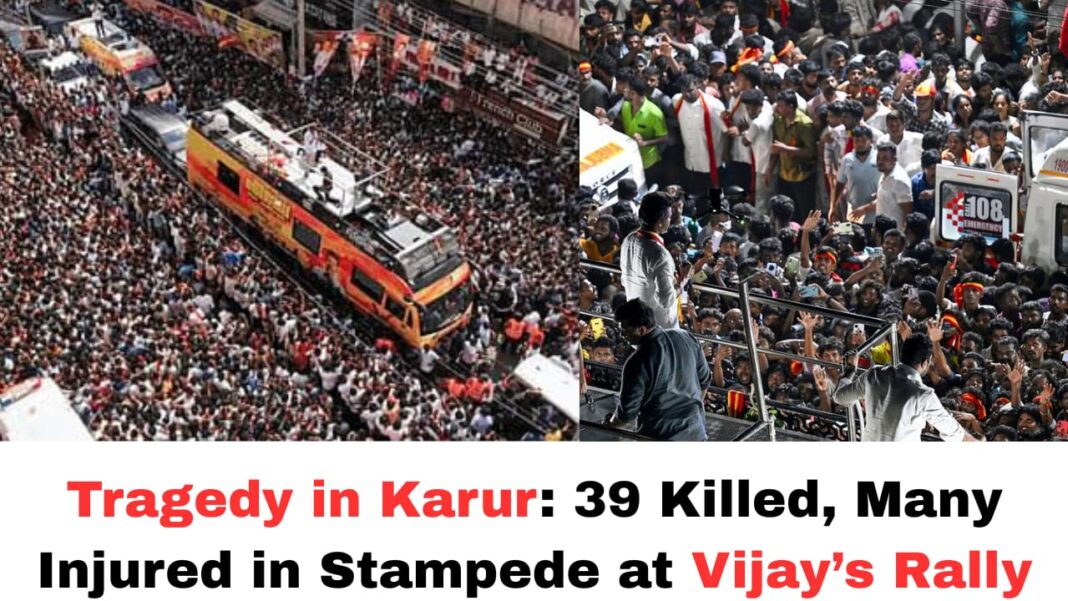Digital News Guru Tamil Nadu Desk:
Vijay Rally Stampede in Karur — What Went Wrong?
A devastating crowd crush at a political rally in Tamil Nadu has shaken the state and the nation, leaving dozens dead and scores more injured. The incident occurred on 27 September 2025 in Karur district, during a campaign event for actor-turned-politician Vijay, founder of the Tamilaga Vettri Kazhagam (TVK) party. The tragedy has exposed deep fault lines in crowd management, political mobilization, and responsibility in large public gatherings.
The Incident
The rally was held in Veluswamypuram, along the Karur–Erode highway. Supporters began gathering early in the day. The event was scheduled for the afternoon, but Vijay’s arrival was delayed by more than six hours—only making an appearance around 7:40 p.m. IST.

By the time he came onto the stage, tens of thousands of people had crammed into the area—many waiting for hours under high heat and without sufficient facilities. As the crowd surged forward to catch a glimpse of Vijay, many lost balance, fainted, or were pressed into barricades. The crush was triggered when large sections moved toward the stage barriers, overwhelming security measures.
Eyewitnesses describe chaotic scenes: people collapsing one over another, unable to move, and barricades being buckled by the sheer force of the crowd pushing forward. Some reportedly fainted from heat exhaustion and suffocation, while others were trampled in the melee. Moments before the worst of it, Vijay was seen pausing his speech, calling for medical help, and tossing water bottles into the crowd. But the pressure and momentum had already spiraled out of control.
Human Cost & Response
As of the latest reports, at least 39 people have died, including men, women, and children. Over 50 people are injured, many in critical condition and receiving intensive treatment. Some accounts, especially from state officials, place the death toll upward of 40 or point to discrepancies as bodies were identified.
In immediate response, the Tamil Nadu government deployed medical teams from neighbouring districts, with about 44 doctors brought into Karur from Tiruchirappalli and Salem. The Karur district administration also set up helplines and emergency response centers to help families search for missing individuals.
Chief Minister M.K. Stalin visited the site and announced a compensation package of Rs 10 lakh (1 million rupees) each for the families of the deceased. He also called for a judicial commission, led by retired judge Aruna Jagadeesan, to investigate the causes and recommend actions.
On the legal front, Tamil Nadu police have filed criminal cases against senior leaders of the TVK party—Bussy Anand, Nirmal Kumar, V.P. Mathiyalagan—in connection with alleged negligence. State authorities contend that permission was granted for a 10,000-person gathering, but attendance far exceeded that number.
Vijay expressed his grief publicly, calling the event “unbearable pain” and pledging to support victims’ families. Prime Minister Narendra Modi also offered condolences, describing the incident as “deeply saddening.”
In Karur district, local business communities responded with solidarity. The Tamil Nadu Federation of Traders’ Association called for a full district-wide shutdown to mourn the victims and protest the tragedy.

Underlying Issues & Questions
The Karur stampede is not just a tragic accident; it surfaces systemic problems in how large political events are organized and managed in India.
- Overcrowding & unrealistic expectations
Despite permitting 10,000 people, TVK rallies routinely draw far more enthusiastic turnout. In Karur, estimates suggest around 27,000 attended—nearly triple the planned number. Such discrepancy puts enormous pressure on any crowd control system.
- Delay & restlessness
Vijay’s late arrival aggravated the situation. The audience spent hours waiting under the sun, lacking food, water, shade, or amenities. Witnesses say restlessness grew before any calamity struck. The crowd dynamics are especially perilous in such scenarios when anticipation peaks and people begin inching forward.
- Weak infrastructure & lack of buffer zones
Officials and analysts point to inadequate barricading, too few exit routes, and poor planning of buffer zones around the stage and ambulance corridors. Once pressure built, the system gave way.
- Insufficient security & disaster preparedness
Police presence and volunteer management were reportedly insufficient given the scale. Inability to contain surges or quickly respond when chaos began magnified the death toll.
- Political spectacle & crowd psychology
In Tamil Nadu, film stars often command the devotion of large, emotionally invested fan bases. Vijay’s political ascent draws its strength from this fervor. But that energy, when mismanaged, can swing from celebration to tragedy.
This raises questions: Should there be stricter caps on public gatherings? Should local administrations enforce crowd limits even on popular political or cultural events? Do political mobilizers bear legal responsibility when turnout exceeds infrastructure capacity?
Political Implications & Repercussions
The tragedy occurs at a politically sensitive time: Tamil Nadu is gearing up for legislative assembly elections in early 2026. TVK, as a newer entrant, has been positioning itself aggressively against both the ruling DMK and the BJP.

During the rally (just before the disaster), Vijay had criticized the DMK government on local issues—airport plans, water bodies, mining, and waste management. In the aftermath, opposition and ruling party actors alike will seize the terrain of accountability, safety norms, and administrative failures.
For TVK, the stampede will test its organizational discipline, public goodwill, and political resolve. If mishandled, it could backfire severely. On the other hand, its response—how it aids victims, cooperates with investigations, and reforms internal protocols—could define its credibility.
For the state government, the probe’s outcomes may implicate multiple actors: local police, event licensing authorities, security agencies, even political organizers. Public pressure will demand not only compensation and justice for the victims, but structural overhauls in how mass political mobilizations are permitted and monitored.
Conclusion
The Karur stampede at Vijay’s rally is a grim reminder of the fragility of mass mobilization when structural safeguards are neglected. What began as a political gathering turned into a night of mourning for dozens of families. As Tamil Nadu and India debate accountability, safety, and political zeal, the questions raised go far beyond one event. In the crucible of tragedy, the hope must be that reforms follow, so that public life—on peaceful grounds—does not become a casualty of its own spectacle.
You May Also Read: BSNL’s 100% Indigenous 4G Rollout: A New Telecom Era








